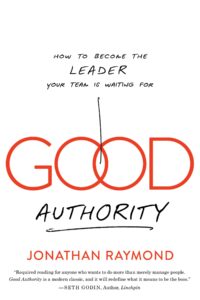Become a Good Authority
What if chasing balance was actually making us unhappy?
What’s the true purpose of work?
Personal and professional growth. We often think they’re different. We live our lives as if the personal and professional are in neat little silos, as if one didn’t affect the other.
I’ve often said that leaders help people with the personal, not just the professional. And sharing a little of the personal may make a big impact in the professional.
The two are interrelated.
And so, when I read Jonathan Raymond’s new work, Good Authority: How to Become the Leader Your Team is Waiting For, I was excited to find a book that explained why this is…and how to use it to become a better leader. Jonathan is the former CEO of EMyth and now the owner of Refound, an advisory firm that offers leadership training and coaching. And I think his take on “good authority” will have you nodding along with what we want from the very best leaders.
Own Your Contribution
Contrast good versus bad authority. What are a few attributes you would think of?
I’d say the first attribute is in the willingness to own your role as an authority in the first place. I see too many modern leaders try to abdicate that responsibility, either outright or in subtle ways, and try to be nice at the expense of giving people the boundaries they need to grow. The main attribute of bad authority is when a leader doesn’t own their contribution to a stuck dynamic or problematic situation. For example, a leader who hasn’t provided a reasonable timeline to reach a goal and then blames the team for not delivering on it fast enough. Good authority is the art of owning your contribution, being transparent with your team, and then moving forward in a collaborative way.
Would you share a little about the concept of “borrowed authority”?
Borrowed authority is the idea that until we investigate the beliefs about authority we inherited from our parents and teachers – not to mention the business culture in general – we’re still borrowing our leadership style from the past instead of discovering the one that genuinely expresses who we are today. In Good Authority, I offer that the opposite of Good Authority isn’t bad authority, it’s borrowed authority. What I mean by that is that most leaders have good intentions, but until we do the work, we’re bogged down by ideas and beliefs about what it means to be the boss that hold us back and create pain and confusion for the employees in our care as a result.
Make it About Relationships
I want to ask about organizational culture. You say, “Nobody sets out to make their employees overwhelmed, stressed-out, and miserable.” I have to say that I read that and laughed, thinking, “If Jonathan only met one of my bad bosses, he’d think differently!” You’re right, of course, but people are overwhelmed and stressed. What’s are some ways to change a culture into one that is positive, empowered, and driven?
 This may sound odd, but the first problem is bad math. One of the things I ask leaders to do is to add up all the time they’re spending (1) doing re-work for a struggling employee, (2) mediating their interpersonal conflicts, (3) answering questions that they should be able to answer themselves, and (4) complaining to their spouse, partner or friends about how frustrated they are. The pivot is incredibly simple and goes against our conditioning, which is why we typically avoid it. The key to create a positive, empowered and driven culture is the exact same thing that will get you out of being overwhelmed and stressed. Repressing what you see and feel leads to emotional, mental, and physical problems, and it keeps that data away from the one person who needs to hear it in order to grow.
This may sound odd, but the first problem is bad math. One of the things I ask leaders to do is to add up all the time they’re spending (1) doing re-work for a struggling employee, (2) mediating their interpersonal conflicts, (3) answering questions that they should be able to answer themselves, and (4) complaining to their spouse, partner or friends about how frustrated they are. The pivot is incredibly simple and goes against our conditioning, which is why we typically avoid it. The key to create a positive, empowered and driven culture is the exact same thing that will get you out of being overwhelmed and stressed. Repressing what you see and feel leads to emotional, mental, and physical problems, and it keeps that data away from the one person who needs to hear it in order to grow.
There’s an art to talking about work in a way that feels personally relevant to your employee, but it boils down to this: Give them feedback not about tasks and projects but about how they’re showing up as a human being. Make it about relationships, feeling their impact on others, how they avoid taking risks—those are the things that people will immediately see as helping them get better at work and at life at the same time. There’s a whole new type of organizational culture that opens up from that simple shift.
How to Become a Great Listener
What are some techniques you use to help coach someone who has problems with listening? How can we all learn to be better listeners at a deeper level?
Before we talk about the deeper cut, one simple technique that’s often used in mediation applies well in the workplace in general. Have the person you’re trying to help repeat back what they heard before responding. Highlight for them what the gaps are between what was said (and, even more importantly, how it was said) and what they heard and how they interpreted it. There’s a lifetime’s worth of personal growth work there.
At a deeper level, and this is something I work on every day, is to re-examine what we think our value is as leaders. That’s a lot of what Good Authority is about: to learn how the highest value we can add to our teams, and in the rest of our lives, is to put our thumb on the side of the scale that’s about creating the space for others to discover that next better version of themselves, as opposed to tending to fill that space ourselves. I love leaders and have so much respect for anyone who throws their heart into a problem with no guarantee of success. The pivot is to see how not everyone works that way, and that to create the organization that can do more than you can on your own, you have to listen for those other voices.
Finally, it comes down to not shooting the messenger. I can’t tell you how many organizations I’ve seen, in fact I’ve never seen one where this isn’t true, where one person becomes a scapegoat for the cultural dysfunction and is moved out (fired or pushed into quitting), and the message they were carrying never sees the full light of day. It’s a basic rule of group dynamics, but I see CEOs do it all the time, moving out the ‘disgruntled’ employee instead of leaning into the conversation and discovering the most powerful brand ambassador they’ve got.
Let Go of the Past
How about letting go of the past? What advice do you give to someone who is letting the past limit their future?
Find a way to get in relationship with it. Meaning, when you notice yourself re-hashing or cycling in an old story, imagine a friend was telling you that story, what would you tell them? It’s a life’s work for sure, but learn to reframe our past in terms of how it made us the person we are today. I heard this phrase again recently that I absolutely love: “The past didn’t happen to us, it happened for us.” To be clear, I’m not suggesting people try and transcend or gloss over traumatic or otherwise difficult personal experiences, only that we hold a bit of double-vision about them. Let yourself feel whatever there is to feel about whatever it is that you feel it’s holding back. Cry, laugh, roll up the car window on the freeway and let out a yell from the depths of your soul. By giving yourself permission to let it be what it is all the way, only then do you open up the room to see it in a new way. The paradox is that you don’t have to do any additional work to do this. It’s the process of giving yourself permission to feel that brings that higher mind back online, and you can move forward with confidence and a sense of self that might surprise you.
How to Increase Accountability
Let’s talk about accountability. Why do most people wait so long to address an issue? How do you coach others to be more specific? How can we use The Accountability Dial to increase accountability?
The biggest gap in management training is that when it comes to giving feedback that people can use to grow, most leaders and managers (from the CEO on down) (1) wait too long to speak up, (2) aren’t specific enough when they do, and (3) don’t create clear consequences and boundaries for what needs to change and by when. They end up lashing out (or being passive aggressive with their employees) as a result. The Accountability Dial is a method I developed to give leaders a process for how to break that cycle, to give feedback in real-time, in a personally supportive and meaningful way, with a clear requirement for change.
Fixers, fighters, and friends. Tell us more about your leadership categorization. How can we use this to help ourselves and others become better leaders?
Fixer, Fighter or Friend came out of a conversation with some of my clients. I’d been doing a lot of speaking about how we, as leaders, disempower our team without realizing it. At some point I saw that there were three different patterns or themes for how different leaders (including myself) are doing that. This archetype system is the result, and it’s been an incredibly helpful frame for leaders to connect long-held professional patterns with their personal values and goals. It’s been fascinating to watch this tool develop and what people are discovering with it. The key is to move beyond what I think is a limiting conversation about strengths and weaknesses as two things, and learn to see who we are as a blend of our best and worst qualities and learning to unlock a future version of ourselves one day at a time.
Do you aspire to be a GOOD authority? By signing up for FREE to Leadership Insights, you will be on your way![/subscribe]
Good Authority: How to Become the Leader Your Team is Waiting For
